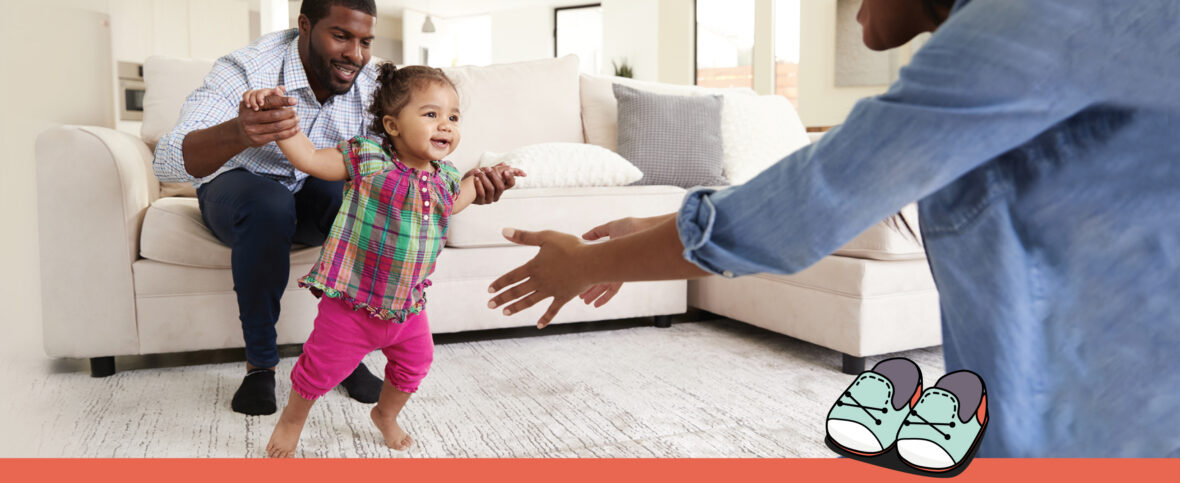See all > Parenthood

Baby’s first steps
Your baby’s first steps seem like proof that magic exists. Their transformation from a helpless newborn to an ambulating, walking menace happens so fast it’s almost unbelievable. But it doesn’t always happen in a straight line. If you’re wondering “how do I encourage my baby to walk unaided?” or at what age you should worry that they’re still not walking, you’ve come to the right place. We’ve compiled everything you need from the best tips to get your baby walking to signs they’ll soon be on their way.
Signs that your baby will walk soon
If your baby is doing squats as well as pulling up on things, you can be pretty sure their first steps are a heartbeat away. From there, they’re likely to move into cruising which is usually the immediate precursor to toddling. No, this doesn’t mean your baby starts checking out other kids in their stroller. Cruising is when they’re taking small steps while holding on to something — usually the furniture.
Some kids add another stop before they start walking known as the one knee drag. This is exactly what it sounds like, meaning they step with one foot while balancing on their knee with the other. While this might wreak havoc on the knees of their pants, it’s otherwise harmless. They’re likely just afraid of falling. Once their confidence catches up they’ll be toddling away with their friends.
How can I help my baby learn to walk?
Your baby is going to walk on her own schedule. So if you’re scouring the internet for secret baby exercises to help her walk sooner, you’re out of luck. But that doesn’t mean you should give up on figuring out how to help your baby walk independently altogether. If you’re super focused on how to help your baby walk sooner, try getting them to crawl or shimmy over different height surfaces, like pillows. This helps them to practice shifting their weight around which will improve their balance. Learning to navigate uneven surfaces will also boost their confidence which they’ll need to take their first independent steps.
If your baby is taking steps but not walking yet, don’t worry! While some kids let go and attempt multiple steps right off the bat, don’t be surprised if your little one takes a more cautious approach. You can encourage them to go longer distances by moving a few inches away and letting them try walking to you. Holding up a favorite item like (gasp) your phone is an added incentive — just make sure it’s in a good case in case they actually get it!
The best shoes for baby’s first steps
A few different brands claim the title of best shoes for baby’s first steps, but that doesn’t make them must-buy items. Most baby shoes will fit the bill, as long as they meet certain criteria. First of all, shoes should be easy to get on. No high tops, for example (they may be super cute, but they’re practically impossible to get on a baby’s foot). Next up, it’s a good idea to find a pair of shoes with decent grip on the bottom. Leather crib shoes are usually fine, but they don’t always provide the traction your baby needs on a slippery floor which can make for some nasty spills. Finally, the shoe should be flexible and comfy. Your baby should have enough space to be able to grip with their toes inside the shoe. Otherwise they’re likely to be both uncomfortable and unsteady.
When do babies start walking?
On average, most babies take their first steps around a year with some beginning as early as nine months and others as late as 15 months. But that doesn’t mean you need to start stressing if your child falls outside of this range. “Normal” is a spectrum, so unless your baby isn’t walking by 18 months, there’s no need to take them to the doctor.
When to worry
If your baby isn’t walking by 18 months, they’re more than likely just a late bloomer. Despite that, they should be seen by a doctor anyways as late walking is sometimes associated with cerebral palsy. This doesn’t mean, however, that your child has cerebral palsy if they’re not walking by 18 months. Poor muscle tone, stiffness in the joints and seemingly uncontrolled movements are all potential signs of cerebral palsy, and are more likely than not walking to be the first signs a parent spots.
Every group of babies has an early walker and a late one. Most other parents have enough tact not to say things like, “he’s not walking yet?!” but it’s often the voice in your own head that causes the most worry. If possible, try not to compare your child to your friends’ kids. We all do things on our own schedule and your child is no exception. With any luck, he’ll potty train at 22 months and learn to make his bed by three. As always, if you’re at all concerned, speak to your child’s pediatrician.
The information presented here is for educational purposes and is not meant to replace the advice from your medical professional.
When using virtual care, all medical treatment is at the sole discretion of the provider. Virtual care is not meant for medical emergencies, and your provider will determine if your case is appropriate for virtual care. If you are experiencing an emergency like chest pain or difficulties breathing, for example, please call 911 or go to your nearest emergency room.
Trusted by millions of Canadians
Get started now

We're trusted by millions of Canadians
Join millions of Canadian families who enjoy 24/7 access to medical care within minutes.
Get started now4.6 score
5K+ Trustpilot reviews
Do you need medical care today?
Trusted, experienced doctors and nurse practitioners are ready to see you.
